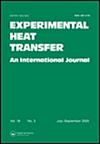利用吸收体肋面粗糙度改善太阳能空气加热器管道性能的实验研究
IF 2.9
3区 工程技术
Q2 ENGINEERING, MECHANICAL
引用次数: 0
摘要
摘要太阳能是一种纯净、丰富的日常生活能源。在众多太阳能热系统中,太阳能空气加热器(SAHs)通常被认为是最经济和实用的加热和干燥室内空间的方法。由于其性能差,传热能力小,在某些情况下的适用性相当有限。本文尝试利用混合肋板来提高SAH的换热效率。混合肋板粗糙度设计用于整合弧形肋板下游的v形肋板,并在SAH导管中进行了雷诺数(RN)在2000至16000之间的实验测试。在30º~ 75º、0.2 ~ 0.8、8 ~ 14和0.036 ~ 0.056范围内,分别具有弧角(α)、相对V肋位置(d/w)、相对肋距(p/e)和相对肋高(e/Dh)等不同的粗糙度模式。结果表明,在α = 45º,d/w = 0.5, p/e = 12, e/ d = 0.056时,NuNu的最大增强值为3.75。热液性能(TP)参数也对所有参数进行了评估,发现在α = 45º,d/w = 0.5, p/e = 12, e/Dh = 0.036时,TP参数最大为2.49。关键词:太阳能空气加热器,传热强化,热工性能,混合肋同时,本论文也构成了第一作者的论文。披露声明作者未报告潜在的利益冲突。设计了v形肋和弧形肋相结合的混合肋粗糙度模式,并在太阳能空气加热器风道中进行了试验。在30º~ 75º、30º~ 75º、0.2 ~ 0.10、8 ~ 10和0.023 ~ 0.043范围内,分别得到了弧角(α)、攻角(β)、相对V肋位置(d/w)、相对肋间距(p/e)和相对肋高(e/ d)等不同的粗糙度分布规律。在α = 45º,β = 60º,d/w = 0.65, p/e = 10, e/ d = 0.043时,NuNu的最大增强为3.75。对混合肋纹各参数的热液性能(TP)参数进行了评价,在α = 30º,β = 60º,d/w = 1.0, p/e = 10, e/ d = 0.043时,TP参数最大值为2.49。本文章由计算机程序翻译,如有差异,请以英文原文为准。
Performance improvement of solar air heater duct-employing rib roughness on absorber: an experimental study
ABSTRACTSolar energy is a pure and plentiful source of power for daily activities. Out of many solar thermal system, Solar air heaters (SAHs) are frequently regarded as the most economical and practical method of heating and drying indoor spaces. Due to its poor performance and minimal heat transfer capacity, its applicability in certain circumstances is quite limited. In this paper, an effort has been made to improve the heat transfer efficiency of SAH by utilizing hybrid ribs. Hybrid rib roughnesses are designed to integrate V-shaped ribs downstream of arc-shaped ribs and were experimentally tested in the SAH duct at Reynolds numbers (RN) between 2000 and 16,000. The various roughness pattern i.e. arc angle (α), relative V ribs position (d/w), relative rib pitch (p/e) and relative rib height (e/Dh) have been exploited in the range of 30º-75º, 0.2–0.8, 8–14 and 0.036–0.056, respectively. As a result, maximum enhancement in NuNu has been found as 3.75 at α = 45º, d/w = 0.5, p/e = 12, e/D = 0.056. Thermohydraulic Performance (TP) parameters have also been evaluated for all set of parameters and it was found to be maximum 2.49 at α = 45º, d/w = 0.5, p/e = 12, and e/Dh = 0.036.KEYWORDS: Solar air heaterheat transfer enhancementthermohydraulic performancehybrid-shaped ribs AcknowledgmentsThis work is carried out under Indo-US Project (GAP-806). Also, this work form the dissertation of the First Author.Disclosure statementNo potential conflict of interest was reported by the author(s).Highlights Hybrid rib roughnesses pattern incorporating to V-shaped ribs and arc-shaped ribs has been designed and tested experimentally in the solar air heater duct.The various roughness pattern i.e. arc angle (α), angle of attack (β), relative V ribs position (d/w), relative rib pitch (p/e) and relative rib height (e/D) have been exploited in the range of 30º-75º, 30º-75º, 0.2-0.10, 8-10, and 0.023-0.043, respectively.Maximum enhancement in NuNu has been found as 3.75 at α = 45º, β = 60º, d/w = 0.65, p/e = 10, e/D = 0.043.Thermohydraulic Performance (TP) parameters have also been evaluated for all set of parameters of hybrid ribs pattern and it found to be maximum 2.49 at α = 30º, β = 60º, d/w = 1.0, p/e = 10, e/D = 0.043.
求助全文
通过发布文献求助,成功后即可免费获取论文全文。
去求助
来源期刊

Experimental Heat Transfer
工程技术-工程:机械
CiteScore
6.30
自引率
37.10%
发文量
61
审稿时长
>12 weeks
期刊介绍:
Experimental Heat Transfer provides a forum for experimentally based high quality research articles and communications in the general area of heat-mass transfer and the related energy fields.
In addition to the established multifaceted areas of heat transfer and the associated thermal energy conversion, transport, and storage, the journal also communicates contributions from new and emerging areas of research such as micro- and nanoscale science and technology, life sciences and biomedical engineering, manufacturing processes, materials science, and engineering. Heat transfer plays an important role in all of these areas, particularly in the form of innovative experiments and systems for direct measurements and analysis, as well as to verify or complement theoretical models.
All submitted manuscripts are subject to initial appraisal by the Editor, and, if found suitable for further consideration, to peer review by independent, anonymous expert referees. All peer reviews are single blind and submission is online via ScholarOne Manuscripts. Original, normal size articles, as well as technical notes are considered. Review articles require previous communication and approval by the Editor before submission for further consideration.
 求助内容:
求助内容: 应助结果提醒方式:
应助结果提醒方式:


